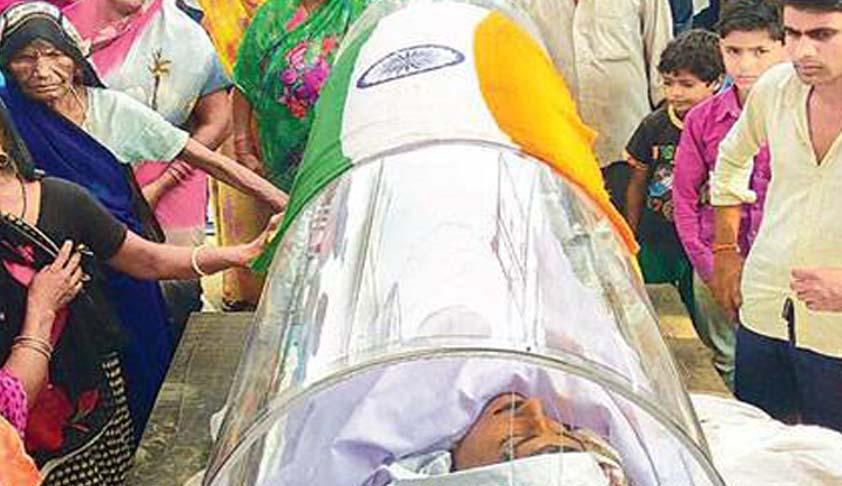Casket Of Dadri Lynching Accused Draped With Indian Flag; Violation Of Flag Code
Kartik Venu
9 Oct 2016 6:00 AM GMT
Photos of the casket of Ravi Sisodia, one of the accused in the Dadri lynching of October 2015 have been circulating in today’s newspapers. The Indian national flag is placed upon his casket, which falls directly in violation with the Flag Code of India 2002. Legally, the custom of the Indian Tricolour being placed over funeral caskets has been reserved for members of the Armed Forces,...
Photos of the casket of Ravi Sisodia, one of the accused in the Dadri lynching of October 2015 have been circulating in today’s newspapers. The Indian national flag is placed upon his casket, which falls directly in violation with the Flag Code of India 2002. Legally, the custom of the Indian Tricolour being placed over funeral caskets has been reserved for members of the Armed Forces, which the deceased does not fall within.
Relevant provisions under the Flag Code of India 2002 are Part 2 Section 1 (iii), which states that
“The Flag shall not be used as a drapery in any form whatsoever, including private funerals,”
or in Part 3 Section 5 (3.22) which states that
“The Flag shall not be used as a drapery in any form whatsoever except in State/Military/Central Para-Military Forces funerals hereinafter provided.”
On Page 1 the Flag Code acknowledges the “universal affection and respect for…yet, a perceptible lack of awareness…in regard to the laws, practices and conventions that apply to the conventions of the National Flag.” In this context the Code was created to streamline guidelines concerning the National Flag taken from erstwhile provisions of the Emblems and Names (Prevention of Improper Use) Act of 1950 as well as the Prevention of Insults to National Honour Act of 1971. The Code provides a comprehensive set of regulations concerning the National Flag. Part 3 of the Code explicitly covers Official Display (Section 2), Correct Display (Section 3), Incorrect Display (Section 4), Misuse (Section 5) as well as Salute (Section 6).
Furthermore, Part 2 Section 1 of the Flag Code of India 2002 to be read with Section 2 of the Prevention of Insults to National Honour 1971 follows as such:
“2.1 There shall be no restriction on the display of the National Flag by members of general public, private organizations, educational institutions, etc, except to the extent provided in the Emblems and Names (Prevention of Improper Use) Act of 1950 and the Prevention of Insults to National Honour Act of 1971 and any other law enacted upon the subject.”
As per Section 2 of the Prevention of Insults to National Honour in 1971,
“Whoever in any public place or in any other place within public view burns, mutilates, defaces, defiles, disfigures, destroys, tramples upon or otherwise shows disrespect to or brings into contempt (whether by words, either spoken or written, or by acts) the Indian National Flag or the Constitution of India or any part thereof, shall be punished with imprisonment for a term which may extend to three years, or with fine, or with both.
Explanation 4 - The disrespect to the Indian National Flag means and includes -
- d) using the Indian National Flag as a drapery in any form whatsoever except in state funerals or armed forces or other para-military forces funerals;”
Are Penal Provisions provided within the Flag Code of India good in law?
Are offences defined within The Flag Code of India 2002 punishable in law? The judgment given in Union of India v Naveen Jindal & Ors 2014 is significant in this context. Though the judgment is remembered in particular for holding that the right of a citizen to wave the national flag falls within their freedom of speech and expression, looking further into the case the Supreme Court mentions the decision of the High Court, which held that:
“The restrictions imposed by the Flag Code on flying the National Flag being not law within the meaning clause (2) of Article 19 of the Constitution of India, the same cannot be construed to be a penal provision. However, if contravention of any of those instructions and guidelines had been issued under the Emblems and Names (Prevention of Improper Use) Act of 1950 or under the Prevention of Insults to National Honour Act of 1971, the same would constitute a penal offence.”
In agreement with the High Court, Supreme Court judgment reads as follows:
“(ii) The fundamental right to fly National Flag is not an absolute right but a qualified one being subject to reasonable restrictions under clause 2 of Article 19 of the Constitution of India;
(iii) The Emblems and Names (Prevention of Improper Use) Act of 1950 and the Prevention of Insults to National Honour Act of 1971 regulate the use of the National Flag;
(iv) Flag Code although is not a law within the meaning of Article 13(3)(a) of the Constitution of India for the purpose of clause (2) of Article 19 thereof, it would not restrictively regulate the free exercise of the right of flying the national flag. However, the Flag Code to the extent it provides for preserving respect and dignity of the National Flag, the same deserves to be followed.”
 Karthik Venu is a Second Year Law Student, DU Faculty of Law.
Karthik Venu is a Second Year Law Student, DU Faculty of Law.
Image from here.
This article has been made possible because of financial support from Independent and Public-Spirited Media Foundation.


